Reasons for Inequity in Indigenous Australians' Cardiovascular Health
VerifiedAdded on 2023/01/10
|9
|2312
|74
AI Summary
This document discusses the reasons for inequity in cardiovascular health between Indigenous and non-Indigenous Australians, focusing on the higher risk of cardiovascular diseases among Indigenous Australians and the contributing factors such as smoking and sedentary lifestyle.
Contribute Materials
Your contribution can guide someone’s learning journey. Share your
documents today.
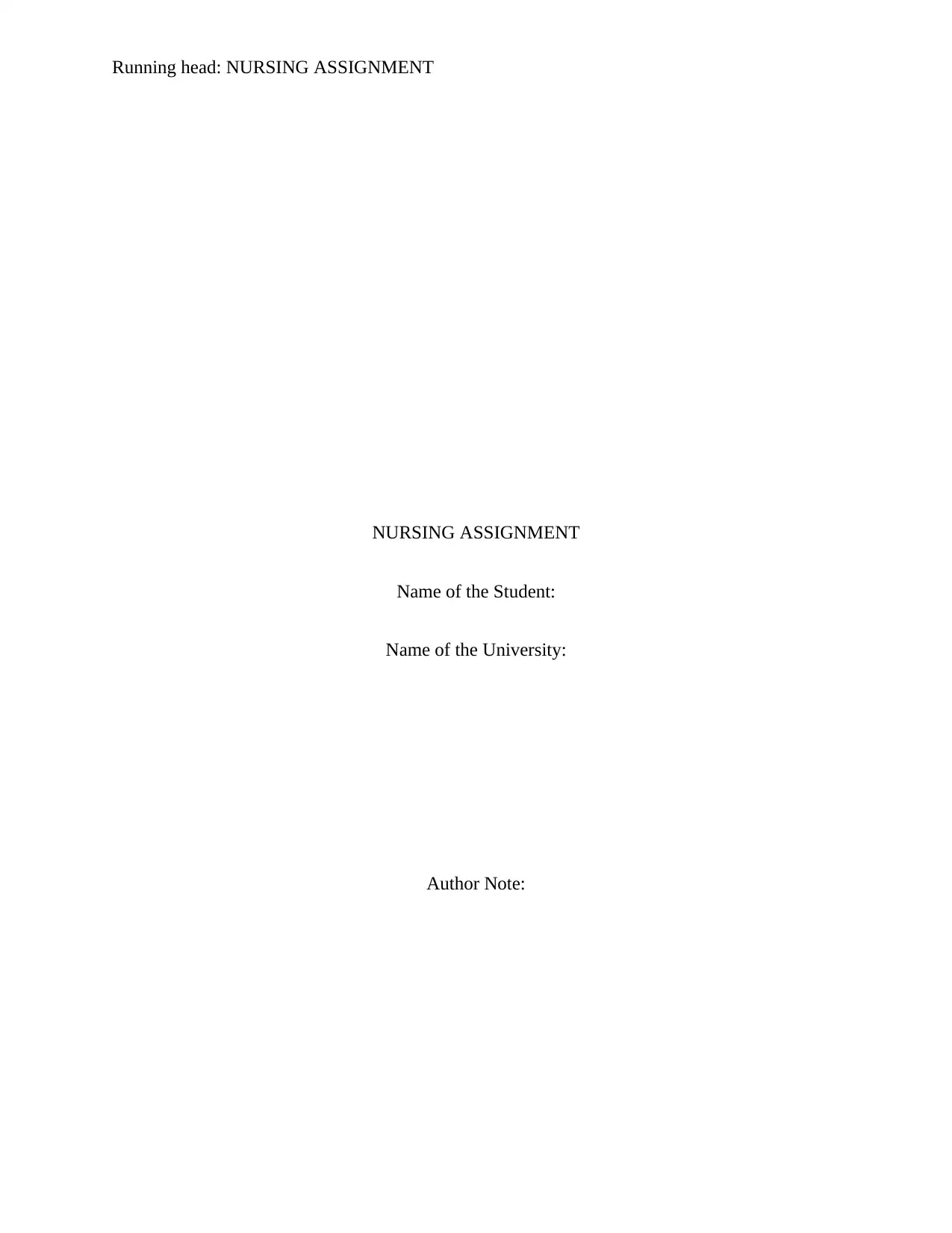
Running head: NURSING ASSIGNMENT
NURSING ASSIGNMENT
Name of the Student:
Name of the University:
Author Note:
NURSING ASSIGNMENT
Name of the Student:
Name of the University:
Author Note:
Secure Best Marks with AI Grader
Need help grading? Try our AI Grader for instant feedback on your assignments.
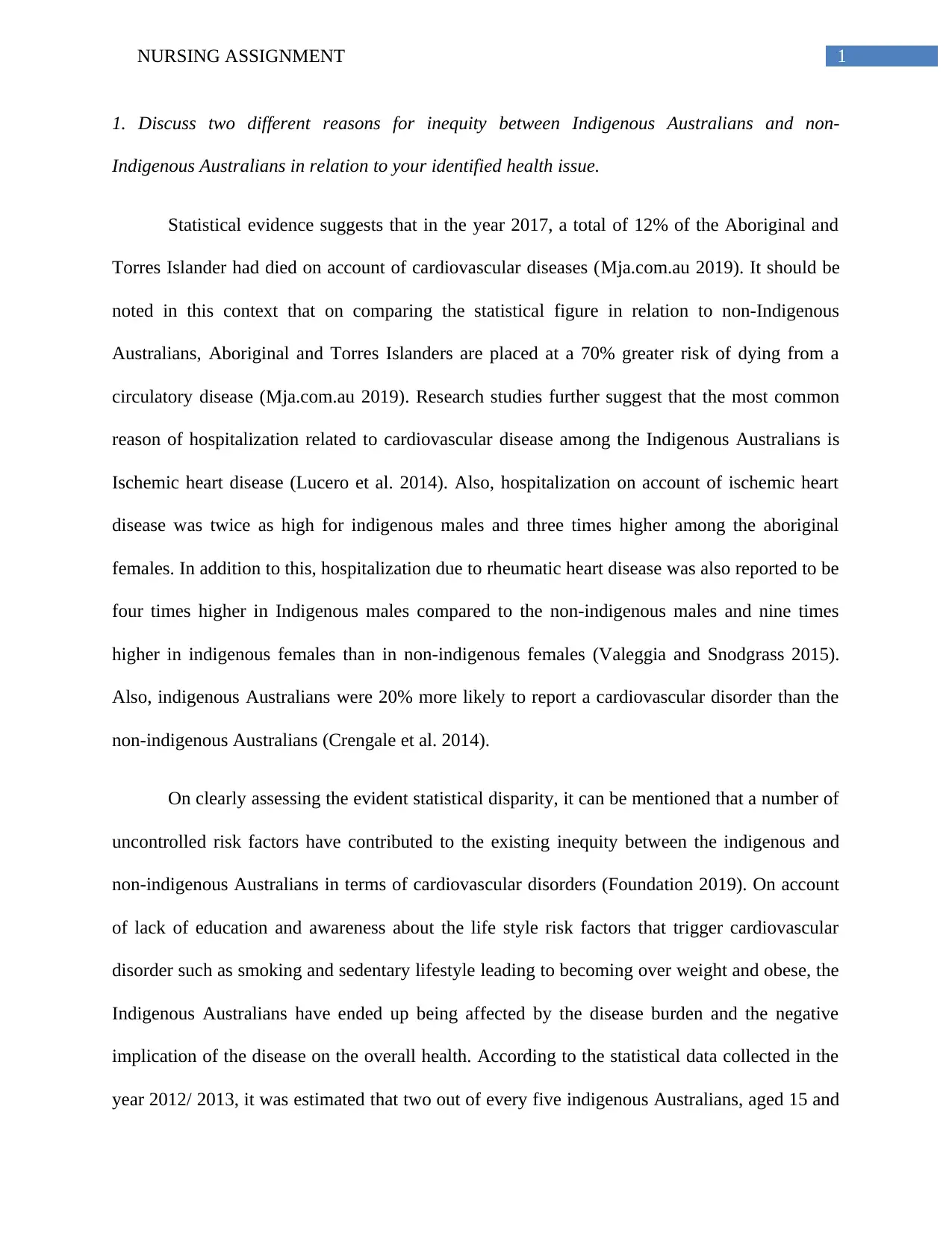
1NURSING ASSIGNMENT
1. Discuss two different reasons for inequity between Indigenous Australians and non-
Indigenous Australians in relation to your identified health issue.
Statistical evidence suggests that in the year 2017, a total of 12% of the Aboriginal and
Torres Islander had died on account of cardiovascular diseases (Mja.com.au 2019). It should be
noted in this context that on comparing the statistical figure in relation to non-Indigenous
Australians, Aboriginal and Torres Islanders are placed at a 70% greater risk of dying from a
circulatory disease (Mja.com.au 2019). Research studies further suggest that the most common
reason of hospitalization related to cardiovascular disease among the Indigenous Australians is
Ischemic heart disease (Lucero et al. 2014). Also, hospitalization on account of ischemic heart
disease was twice as high for indigenous males and three times higher among the aboriginal
females. In addition to this, hospitalization due to rheumatic heart disease was also reported to be
four times higher in Indigenous males compared to the non-indigenous males and nine times
higher in indigenous females than in non-indigenous females (Valeggia and Snodgrass 2015).
Also, indigenous Australians were 20% more likely to report a cardiovascular disorder than the
non-indigenous Australians (Crengale et al. 2014).
On clearly assessing the evident statistical disparity, it can be mentioned that a number of
uncontrolled risk factors have contributed to the existing inequity between the indigenous and
non-indigenous Australians in terms of cardiovascular disorders (Foundation 2019). On account
of lack of education and awareness about the life style risk factors that trigger cardiovascular
disorder such as smoking and sedentary lifestyle leading to becoming over weight and obese, the
Indigenous Australians have ended up being affected by the disease burden and the negative
implication of the disease on the overall health. According to the statistical data collected in the
year 2012/ 2013, it was estimated that two out of every five indigenous Australians, aged 15 and
1. Discuss two different reasons for inequity between Indigenous Australians and non-
Indigenous Australians in relation to your identified health issue.
Statistical evidence suggests that in the year 2017, a total of 12% of the Aboriginal and
Torres Islander had died on account of cardiovascular diseases (Mja.com.au 2019). It should be
noted in this context that on comparing the statistical figure in relation to non-Indigenous
Australians, Aboriginal and Torres Islanders are placed at a 70% greater risk of dying from a
circulatory disease (Mja.com.au 2019). Research studies further suggest that the most common
reason of hospitalization related to cardiovascular disease among the Indigenous Australians is
Ischemic heart disease (Lucero et al. 2014). Also, hospitalization on account of ischemic heart
disease was twice as high for indigenous males and three times higher among the aboriginal
females. In addition to this, hospitalization due to rheumatic heart disease was also reported to be
four times higher in Indigenous males compared to the non-indigenous males and nine times
higher in indigenous females than in non-indigenous females (Valeggia and Snodgrass 2015).
Also, indigenous Australians were 20% more likely to report a cardiovascular disorder than the
non-indigenous Australians (Crengale et al. 2014).
On clearly assessing the evident statistical disparity, it can be mentioned that a number of
uncontrolled risk factors have contributed to the existing inequity between the indigenous and
non-indigenous Australians in terms of cardiovascular disorders (Foundation 2019). On account
of lack of education and awareness about the life style risk factors that trigger cardiovascular
disorder such as smoking and sedentary lifestyle leading to becoming over weight and obese, the
Indigenous Australians have ended up being affected by the disease burden and the negative
implication of the disease on the overall health. According to the statistical data collected in the
year 2012/ 2013, it was estimated that two out of every five indigenous Australians, aged 15 and
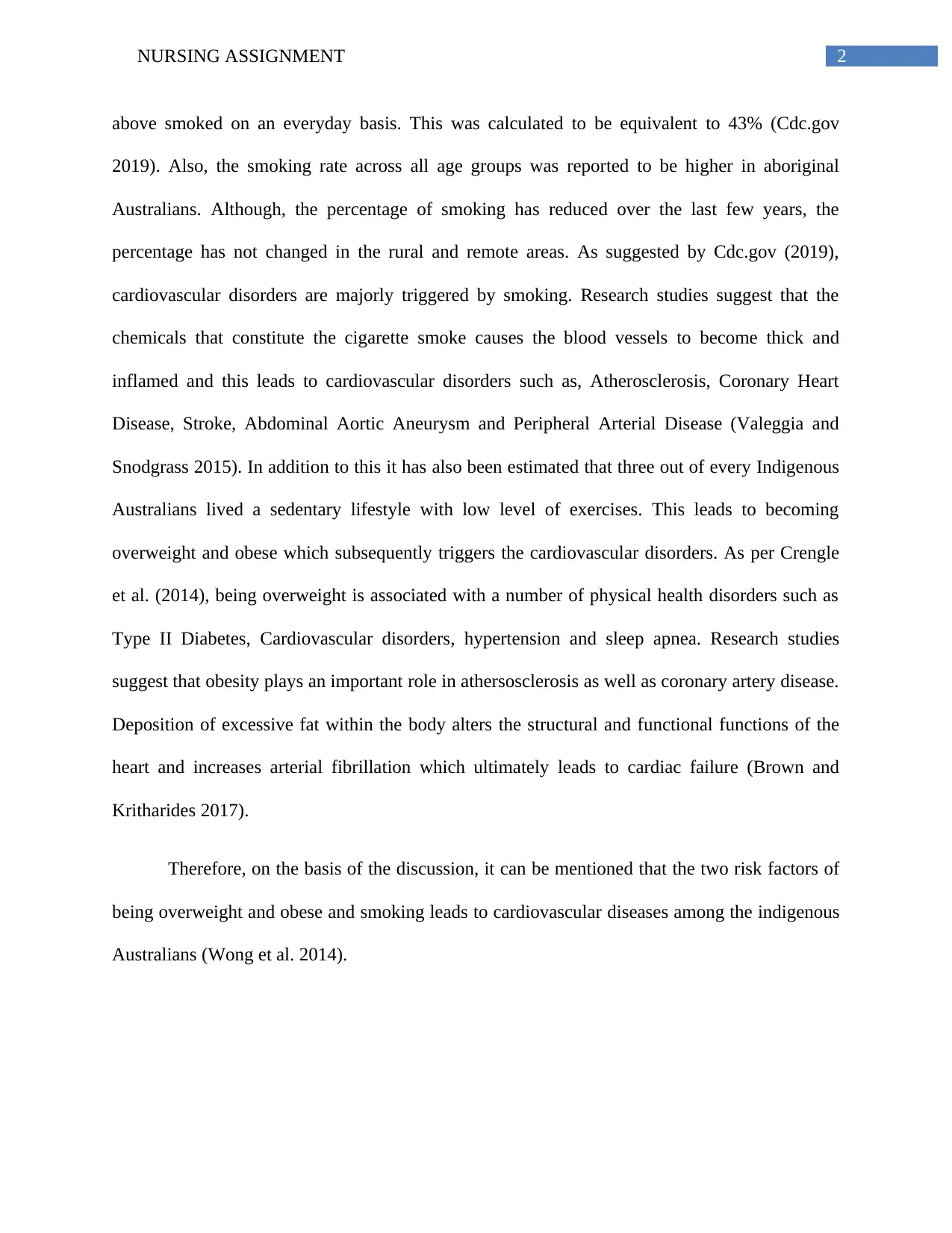
2NURSING ASSIGNMENT
above smoked on an everyday basis. This was calculated to be equivalent to 43% (Cdc.gov
2019). Also, the smoking rate across all age groups was reported to be higher in aboriginal
Australians. Although, the percentage of smoking has reduced over the last few years, the
percentage has not changed in the rural and remote areas. As suggested by Cdc.gov (2019),
cardiovascular disorders are majorly triggered by smoking. Research studies suggest that the
chemicals that constitute the cigarette smoke causes the blood vessels to become thick and
inflamed and this leads to cardiovascular disorders such as, Atherosclerosis, Coronary Heart
Disease, Stroke, Abdominal Aortic Aneurysm and Peripheral Arterial Disease (Valeggia and
Snodgrass 2015). In addition to this it has also been estimated that three out of every Indigenous
Australians lived a sedentary lifestyle with low level of exercises. This leads to becoming
overweight and obese which subsequently triggers the cardiovascular disorders. As per Crengle
et al. (2014), being overweight is associated with a number of physical health disorders such as
Type II Diabetes, Cardiovascular disorders, hypertension and sleep apnea. Research studies
suggest that obesity plays an important role in athersosclerosis as well as coronary artery disease.
Deposition of excessive fat within the body alters the structural and functional functions of the
heart and increases arterial fibrillation which ultimately leads to cardiac failure (Brown and
Kritharides 2017).
Therefore, on the basis of the discussion, it can be mentioned that the two risk factors of
being overweight and obese and smoking leads to cardiovascular diseases among the indigenous
Australians (Wong et al. 2014).
above smoked on an everyday basis. This was calculated to be equivalent to 43% (Cdc.gov
2019). Also, the smoking rate across all age groups was reported to be higher in aboriginal
Australians. Although, the percentage of smoking has reduced over the last few years, the
percentage has not changed in the rural and remote areas. As suggested by Cdc.gov (2019),
cardiovascular disorders are majorly triggered by smoking. Research studies suggest that the
chemicals that constitute the cigarette smoke causes the blood vessels to become thick and
inflamed and this leads to cardiovascular disorders such as, Atherosclerosis, Coronary Heart
Disease, Stroke, Abdominal Aortic Aneurysm and Peripheral Arterial Disease (Valeggia and
Snodgrass 2015). In addition to this it has also been estimated that three out of every Indigenous
Australians lived a sedentary lifestyle with low level of exercises. This leads to becoming
overweight and obese which subsequently triggers the cardiovascular disorders. As per Crengle
et al. (2014), being overweight is associated with a number of physical health disorders such as
Type II Diabetes, Cardiovascular disorders, hypertension and sleep apnea. Research studies
suggest that obesity plays an important role in athersosclerosis as well as coronary artery disease.
Deposition of excessive fat within the body alters the structural and functional functions of the
heart and increases arterial fibrillation which ultimately leads to cardiac failure (Brown and
Kritharides 2017).
Therefore, on the basis of the discussion, it can be mentioned that the two risk factors of
being overweight and obese and smoking leads to cardiovascular diseases among the indigenous
Australians (Wong et al. 2014).
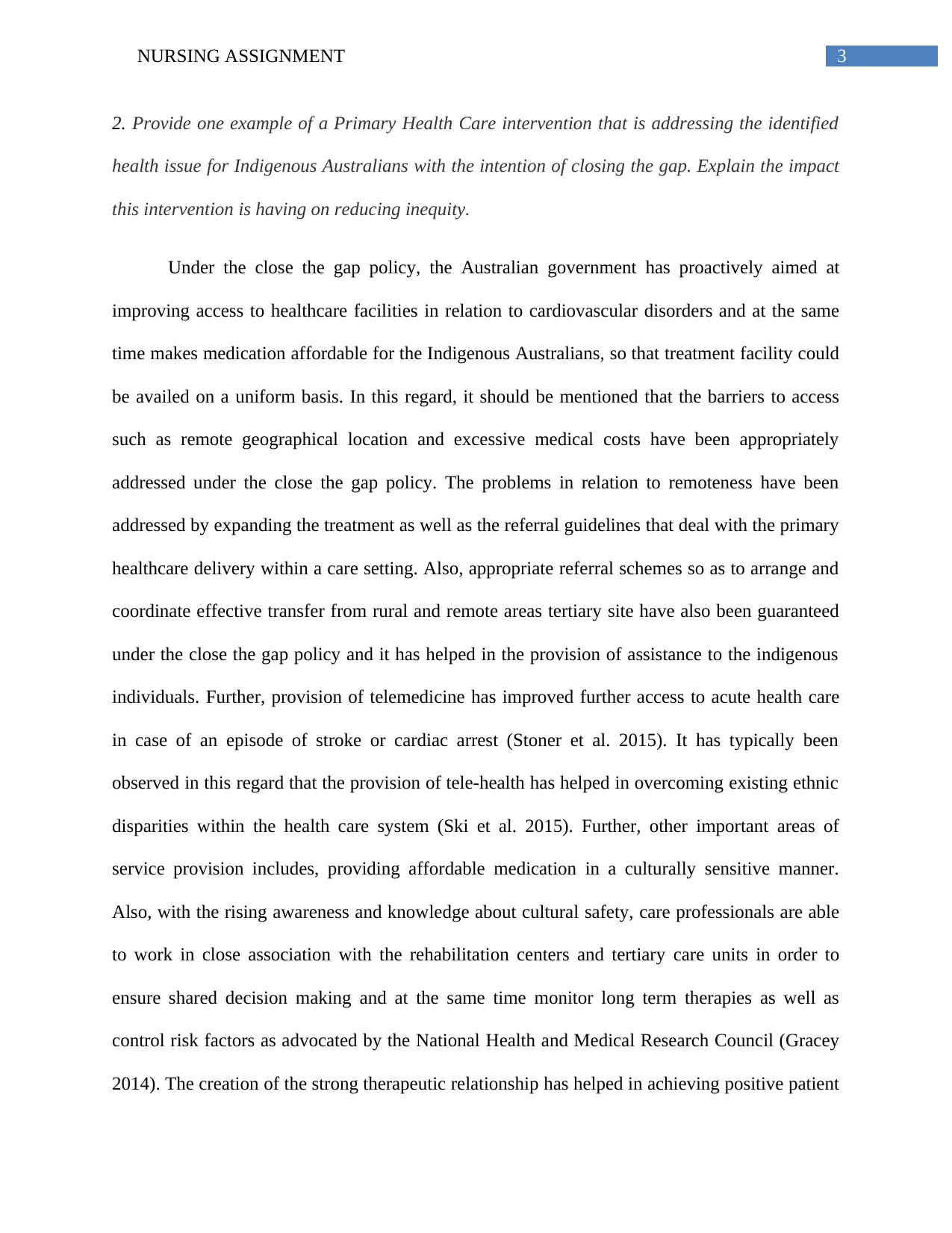
3NURSING ASSIGNMENT
2. Provide one example of a Primary Health Care intervention that is addressing the identified
health issue for Indigenous Australians with the intention of closing the gap. Explain the impact
this intervention is having on reducing inequity.
Under the close the gap policy, the Australian government has proactively aimed at
improving access to healthcare facilities in relation to cardiovascular disorders and at the same
time makes medication affordable for the Indigenous Australians, so that treatment facility could
be availed on a uniform basis. In this regard, it should be mentioned that the barriers to access
such as remote geographical location and excessive medical costs have been appropriately
addressed under the close the gap policy. The problems in relation to remoteness have been
addressed by expanding the treatment as well as the referral guidelines that deal with the primary
healthcare delivery within a care setting. Also, appropriate referral schemes so as to arrange and
coordinate effective transfer from rural and remote areas tertiary site have also been guaranteed
under the close the gap policy and it has helped in the provision of assistance to the indigenous
individuals. Further, provision of telemedicine has improved further access to acute health care
in case of an episode of stroke or cardiac arrest (Stoner et al. 2015). It has typically been
observed in this regard that the provision of tele-health has helped in overcoming existing ethnic
disparities within the health care system (Ski et al. 2015). Further, other important areas of
service provision includes, providing affordable medication in a culturally sensitive manner.
Also, with the rising awareness and knowledge about cultural safety, care professionals are able
to work in close association with the rehabilitation centers and tertiary care units in order to
ensure shared decision making and at the same time monitor long term therapies as well as
control risk factors as advocated by the National Health and Medical Research Council (Gracey
2014). The creation of the strong therapeutic relationship has helped in achieving positive patient
2. Provide one example of a Primary Health Care intervention that is addressing the identified
health issue for Indigenous Australians with the intention of closing the gap. Explain the impact
this intervention is having on reducing inequity.
Under the close the gap policy, the Australian government has proactively aimed at
improving access to healthcare facilities in relation to cardiovascular disorders and at the same
time makes medication affordable for the Indigenous Australians, so that treatment facility could
be availed on a uniform basis. In this regard, it should be mentioned that the barriers to access
such as remote geographical location and excessive medical costs have been appropriately
addressed under the close the gap policy. The problems in relation to remoteness have been
addressed by expanding the treatment as well as the referral guidelines that deal with the primary
healthcare delivery within a care setting. Also, appropriate referral schemes so as to arrange and
coordinate effective transfer from rural and remote areas tertiary site have also been guaranteed
under the close the gap policy and it has helped in the provision of assistance to the indigenous
individuals. Further, provision of telemedicine has improved further access to acute health care
in case of an episode of stroke or cardiac arrest (Stoner et al. 2015). It has typically been
observed in this regard that the provision of tele-health has helped in overcoming existing ethnic
disparities within the health care system (Ski et al. 2015). Further, other important areas of
service provision includes, providing affordable medication in a culturally sensitive manner.
Also, with the rising awareness and knowledge about cultural safety, care professionals are able
to work in close association with the rehabilitation centers and tertiary care units in order to
ensure shared decision making and at the same time monitor long term therapies as well as
control risk factors as advocated by the National Health and Medical Research Council (Gracey
2014). The creation of the strong therapeutic relationship has helped in achieving positive patient
Secure Best Marks with AI Grader
Need help grading? Try our AI Grader for instant feedback on your assignments.
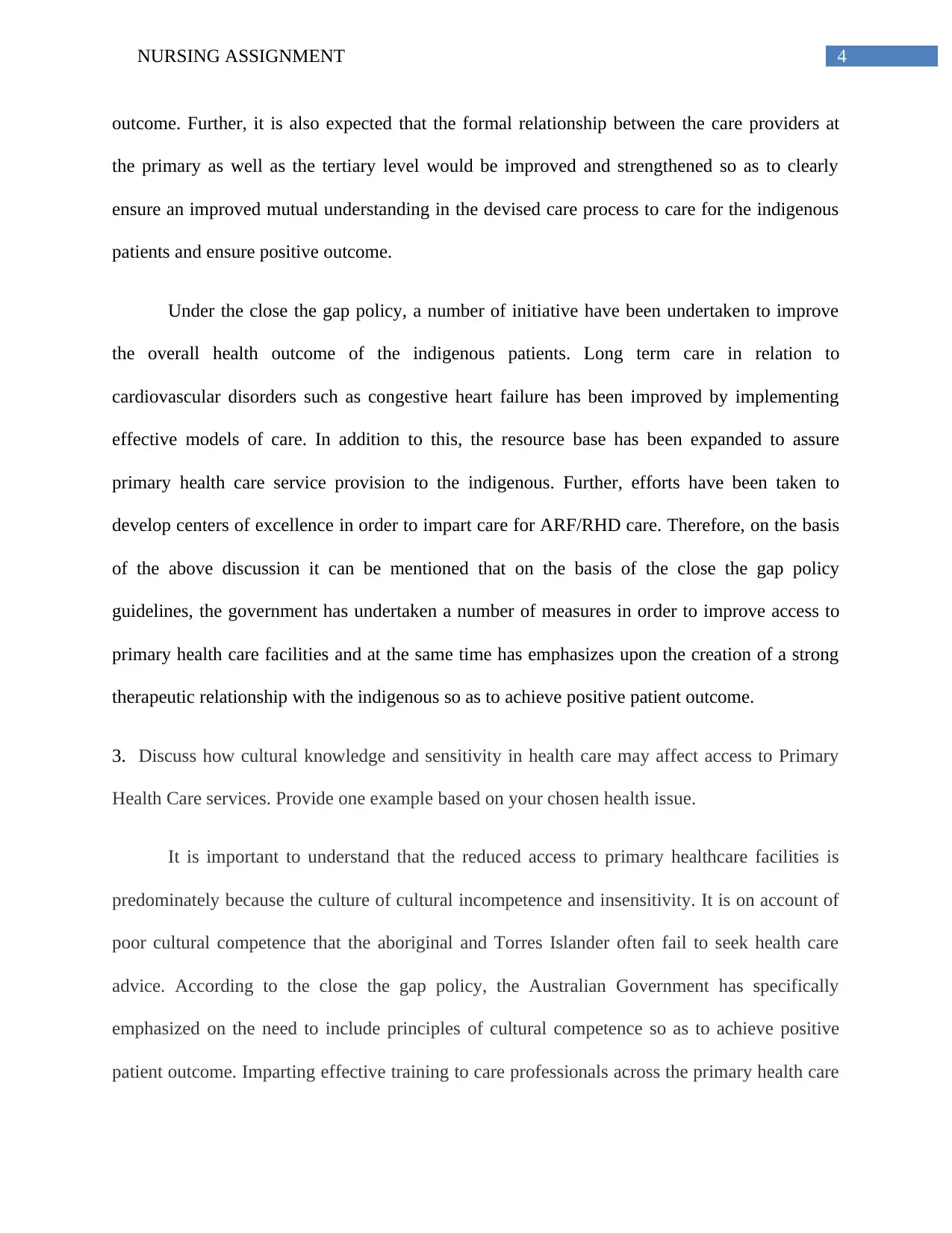
4NURSING ASSIGNMENT
outcome. Further, it is also expected that the formal relationship between the care providers at
the primary as well as the tertiary level would be improved and strengthened so as to clearly
ensure an improved mutual understanding in the devised care process to care for the indigenous
patients and ensure positive outcome.
Under the close the gap policy, a number of initiative have been undertaken to improve
the overall health outcome of the indigenous patients. Long term care in relation to
cardiovascular disorders such as congestive heart failure has been improved by implementing
effective models of care. In addition to this, the resource base has been expanded to assure
primary health care service provision to the indigenous. Further, efforts have been taken to
develop centers of excellence in order to impart care for ARF/RHD care. Therefore, on the basis
of the above discussion it can be mentioned that on the basis of the close the gap policy
guidelines, the government has undertaken a number of measures in order to improve access to
primary health care facilities and at the same time has emphasizes upon the creation of a strong
therapeutic relationship with the indigenous so as to achieve positive patient outcome.
3. Discuss how cultural knowledge and sensitivity in health care may affect access to Primary
Health Care services. Provide one example based on your chosen health issue.
It is important to understand that the reduced access to primary healthcare facilities is
predominately because the culture of cultural incompetence and insensitivity. It is on account of
poor cultural competence that the aboriginal and Torres Islander often fail to seek health care
advice. According to the close the gap policy, the Australian Government has specifically
emphasized on the need to include principles of cultural competence so as to achieve positive
patient outcome. Imparting effective training to care professionals across the primary health care
outcome. Further, it is also expected that the formal relationship between the care providers at
the primary as well as the tertiary level would be improved and strengthened so as to clearly
ensure an improved mutual understanding in the devised care process to care for the indigenous
patients and ensure positive outcome.
Under the close the gap policy, a number of initiative have been undertaken to improve
the overall health outcome of the indigenous patients. Long term care in relation to
cardiovascular disorders such as congestive heart failure has been improved by implementing
effective models of care. In addition to this, the resource base has been expanded to assure
primary health care service provision to the indigenous. Further, efforts have been taken to
develop centers of excellence in order to impart care for ARF/RHD care. Therefore, on the basis
of the above discussion it can be mentioned that on the basis of the close the gap policy
guidelines, the government has undertaken a number of measures in order to improve access to
primary health care facilities and at the same time has emphasizes upon the creation of a strong
therapeutic relationship with the indigenous so as to achieve positive patient outcome.
3. Discuss how cultural knowledge and sensitivity in health care may affect access to Primary
Health Care services. Provide one example based on your chosen health issue.
It is important to understand that the reduced access to primary healthcare facilities is
predominately because the culture of cultural incompetence and insensitivity. It is on account of
poor cultural competence that the aboriginal and Torres Islander often fail to seek health care
advice. According to the close the gap policy, the Australian Government has specifically
emphasized on the need to include principles of cultural competence so as to achieve positive
patient outcome. Imparting effective training to care professionals across the primary health care
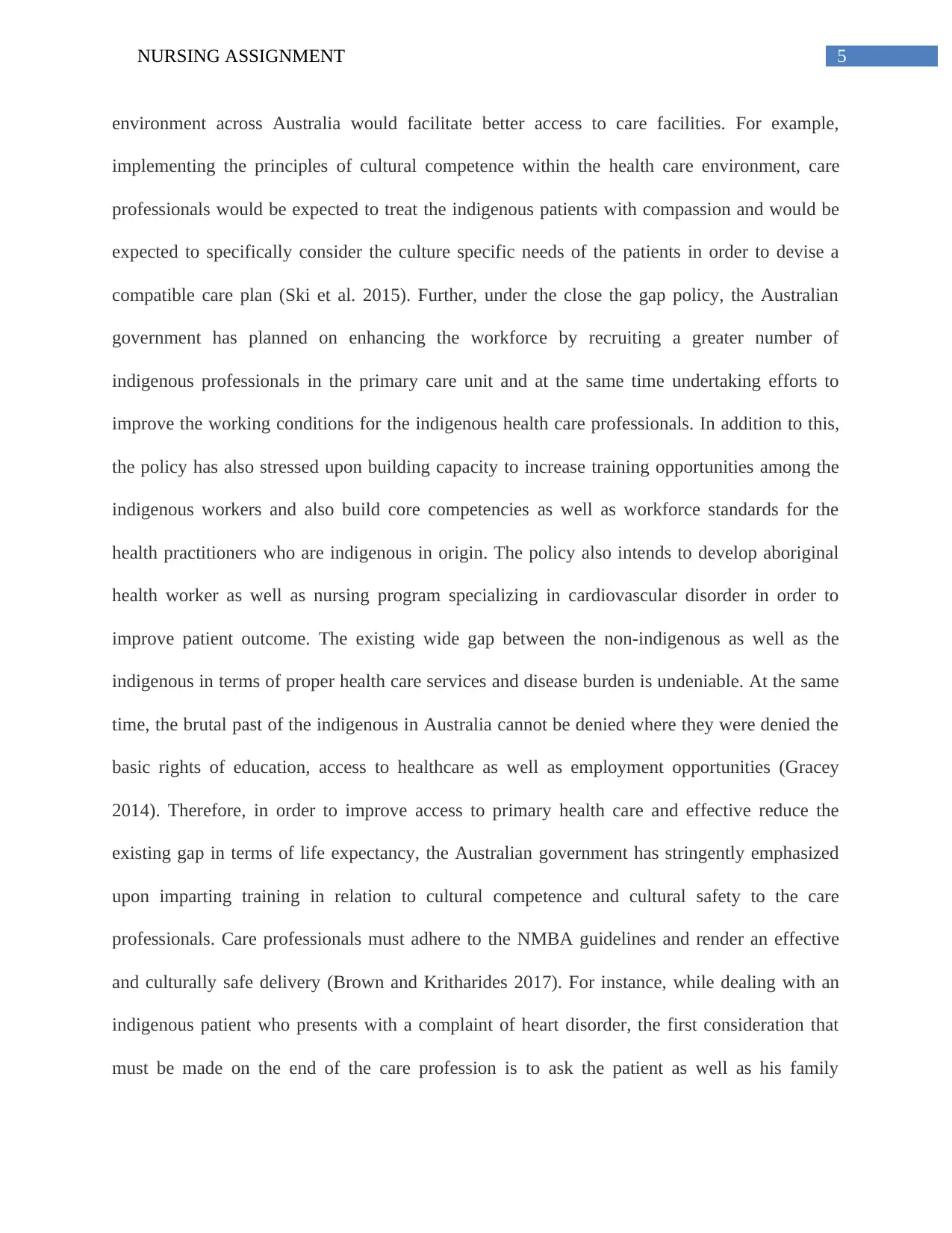
5NURSING ASSIGNMENT
environment across Australia would facilitate better access to care facilities. For example,
implementing the principles of cultural competence within the health care environment, care
professionals would be expected to treat the indigenous patients with compassion and would be
expected to specifically consider the culture specific needs of the patients in order to devise a
compatible care plan (Ski et al. 2015). Further, under the close the gap policy, the Australian
government has planned on enhancing the workforce by recruiting a greater number of
indigenous professionals in the primary care unit and at the same time undertaking efforts to
improve the working conditions for the indigenous health care professionals. In addition to this,
the policy has also stressed upon building capacity to increase training opportunities among the
indigenous workers and also build core competencies as well as workforce standards for the
health practitioners who are indigenous in origin. The policy also intends to develop aboriginal
health worker as well as nursing program specializing in cardiovascular disorder in order to
improve patient outcome. The existing wide gap between the non-indigenous as well as the
indigenous in terms of proper health care services and disease burden is undeniable. At the same
time, the brutal past of the indigenous in Australia cannot be denied where they were denied the
basic rights of education, access to healthcare as well as employment opportunities (Gracey
2014). Therefore, in order to improve access to primary health care and effective reduce the
existing gap in terms of life expectancy, the Australian government has stringently emphasized
upon imparting training in relation to cultural competence and cultural safety to the care
professionals. Care professionals must adhere to the NMBA guidelines and render an effective
and culturally safe delivery (Brown and Kritharides 2017). For instance, while dealing with an
indigenous patient who presents with a complaint of heart disorder, the first consideration that
must be made on the end of the care profession is to ask the patient as well as his family
environment across Australia would facilitate better access to care facilities. For example,
implementing the principles of cultural competence within the health care environment, care
professionals would be expected to treat the indigenous patients with compassion and would be
expected to specifically consider the culture specific needs of the patients in order to devise a
compatible care plan (Ski et al. 2015). Further, under the close the gap policy, the Australian
government has planned on enhancing the workforce by recruiting a greater number of
indigenous professionals in the primary care unit and at the same time undertaking efforts to
improve the working conditions for the indigenous health care professionals. In addition to this,
the policy has also stressed upon building capacity to increase training opportunities among the
indigenous workers and also build core competencies as well as workforce standards for the
health practitioners who are indigenous in origin. The policy also intends to develop aboriginal
health worker as well as nursing program specializing in cardiovascular disorder in order to
improve patient outcome. The existing wide gap between the non-indigenous as well as the
indigenous in terms of proper health care services and disease burden is undeniable. At the same
time, the brutal past of the indigenous in Australia cannot be denied where they were denied the
basic rights of education, access to healthcare as well as employment opportunities (Gracey
2014). Therefore, in order to improve access to primary health care and effective reduce the
existing gap in terms of life expectancy, the Australian government has stringently emphasized
upon imparting training in relation to cultural competence and cultural safety to the care
professionals. Care professionals must adhere to the NMBA guidelines and render an effective
and culturally safe delivery (Brown and Kritharides 2017). For instance, while dealing with an
indigenous patient who presents with a complaint of heart disorder, the first consideration that
must be made on the end of the care profession is to ask the patient as well as his family
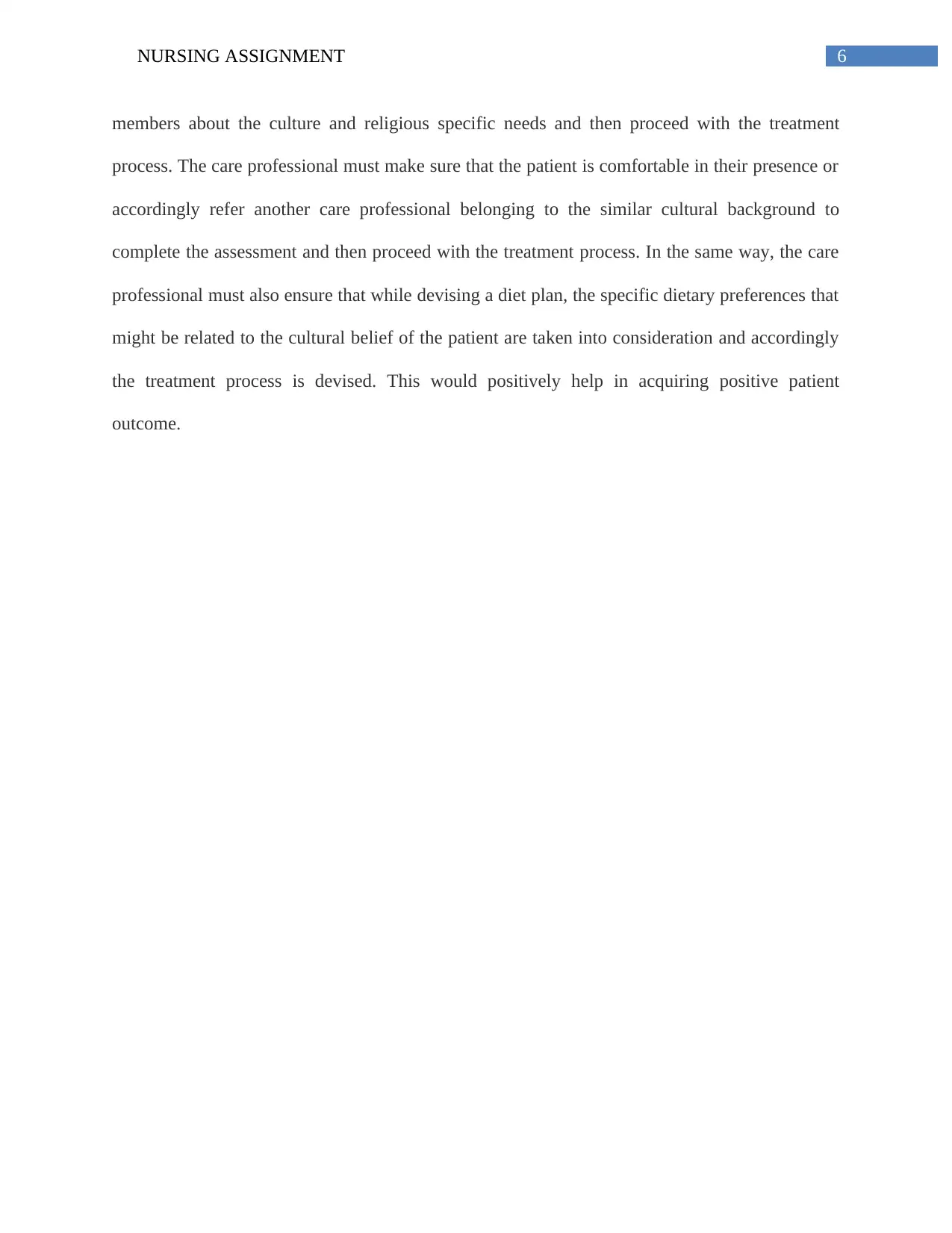
6NURSING ASSIGNMENT
members about the culture and religious specific needs and then proceed with the treatment
process. The care professional must make sure that the patient is comfortable in their presence or
accordingly refer another care professional belonging to the similar cultural background to
complete the assessment and then proceed with the treatment process. In the same way, the care
professional must also ensure that while devising a diet plan, the specific dietary preferences that
might be related to the cultural belief of the patient are taken into consideration and accordingly
the treatment process is devised. This would positively help in acquiring positive patient
outcome.
members about the culture and religious specific needs and then proceed with the treatment
process. The care professional must make sure that the patient is comfortable in their presence or
accordingly refer another care professional belonging to the similar cultural background to
complete the assessment and then proceed with the treatment process. In the same way, the care
professional must also ensure that while devising a diet plan, the specific dietary preferences that
might be related to the cultural belief of the patient are taken into consideration and accordingly
the treatment process is devised. This would positively help in acquiring positive patient
outcome.
Paraphrase This Document
Need a fresh take? Get an instant paraphrase of this document with our AI Paraphraser
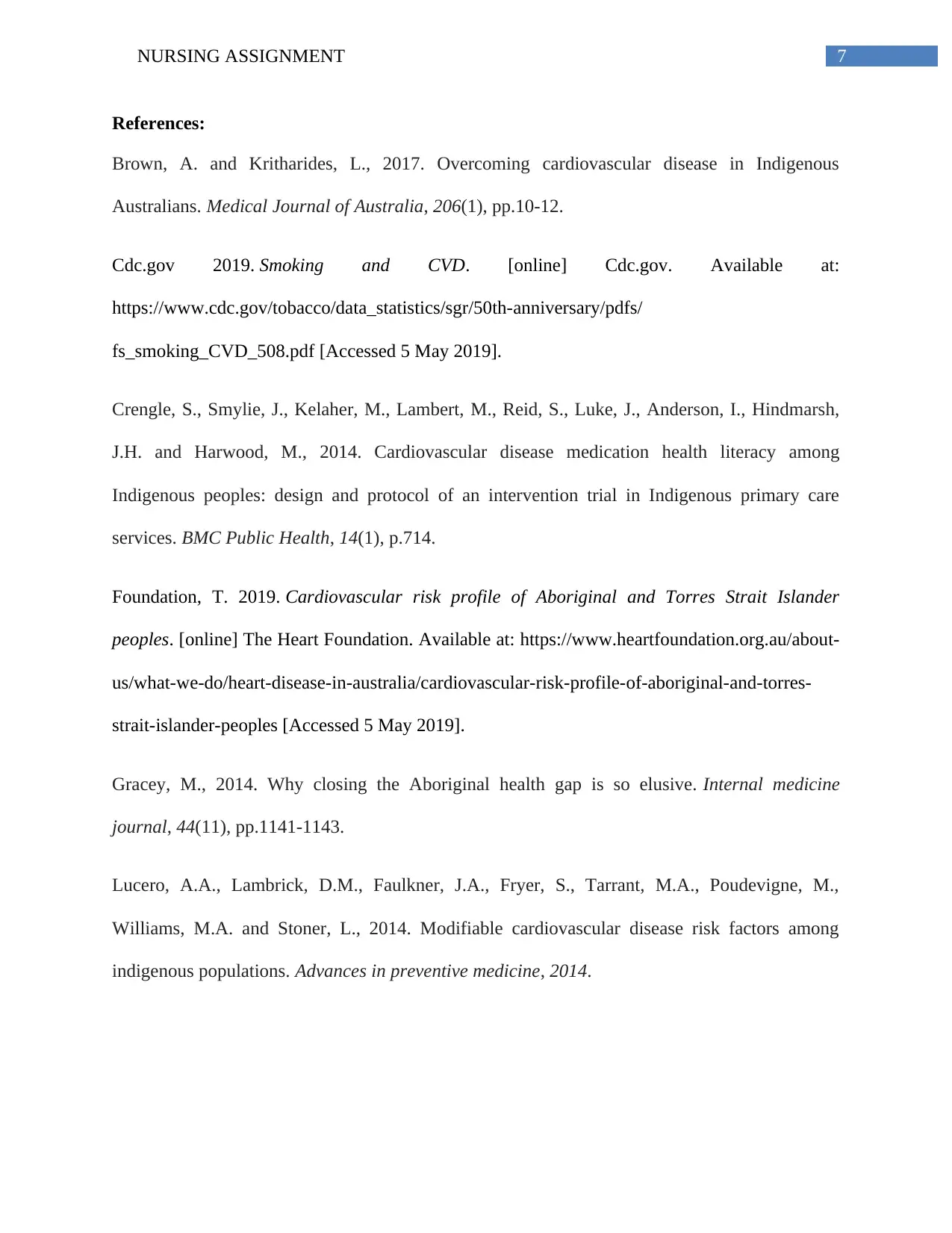
7NURSING ASSIGNMENT
References:
Brown, A. and Kritharides, L., 2017. Overcoming cardiovascular disease in Indigenous
Australians. Medical Journal of Australia, 206(1), pp.10-12.
Cdc.gov 2019. Smoking and CVD. [online] Cdc.gov. Available at:
https://www.cdc.gov/tobacco/data_statistics/sgr/50th-anniversary/pdfs/
fs_smoking_CVD_508.pdf [Accessed 5 May 2019].
Crengle, S., Smylie, J., Kelaher, M., Lambert, M., Reid, S., Luke, J., Anderson, I., Hindmarsh,
J.H. and Harwood, M., 2014. Cardiovascular disease medication health literacy among
Indigenous peoples: design and protocol of an intervention trial in Indigenous primary care
services. BMC Public Health, 14(1), p.714.
Foundation, T. 2019. Cardiovascular risk profile of Aboriginal and Torres Strait Islander
peoples. [online] The Heart Foundation. Available at: https://www.heartfoundation.org.au/about-
us/what-we-do/heart-disease-in-australia/cardiovascular-risk-profile-of-aboriginal-and-torres-
strait-islander-peoples [Accessed 5 May 2019].
Gracey, M., 2014. Why closing the Aboriginal health gap is so elusive. Internal medicine
journal, 44(11), pp.1141-1143.
Lucero, A.A., Lambrick, D.M., Faulkner, J.A., Fryer, S., Tarrant, M.A., Poudevigne, M.,
Williams, M.A. and Stoner, L., 2014. Modifiable cardiovascular disease risk factors among
indigenous populations. Advances in preventive medicine, 2014.
References:
Brown, A. and Kritharides, L., 2017. Overcoming cardiovascular disease in Indigenous
Australians. Medical Journal of Australia, 206(1), pp.10-12.
Cdc.gov 2019. Smoking and CVD. [online] Cdc.gov. Available at:
https://www.cdc.gov/tobacco/data_statistics/sgr/50th-anniversary/pdfs/
fs_smoking_CVD_508.pdf [Accessed 5 May 2019].
Crengle, S., Smylie, J., Kelaher, M., Lambert, M., Reid, S., Luke, J., Anderson, I., Hindmarsh,
J.H. and Harwood, M., 2014. Cardiovascular disease medication health literacy among
Indigenous peoples: design and protocol of an intervention trial in Indigenous primary care
services. BMC Public Health, 14(1), p.714.
Foundation, T. 2019. Cardiovascular risk profile of Aboriginal and Torres Strait Islander
peoples. [online] The Heart Foundation. Available at: https://www.heartfoundation.org.au/about-
us/what-we-do/heart-disease-in-australia/cardiovascular-risk-profile-of-aboriginal-and-torres-
strait-islander-peoples [Accessed 5 May 2019].
Gracey, M., 2014. Why closing the Aboriginal health gap is so elusive. Internal medicine
journal, 44(11), pp.1141-1143.
Lucero, A.A., Lambrick, D.M., Faulkner, J.A., Fryer, S., Tarrant, M.A., Poudevigne, M.,
Williams, M.A. and Stoner, L., 2014. Modifiable cardiovascular disease risk factors among
indigenous populations. Advances in preventive medicine, 2014.
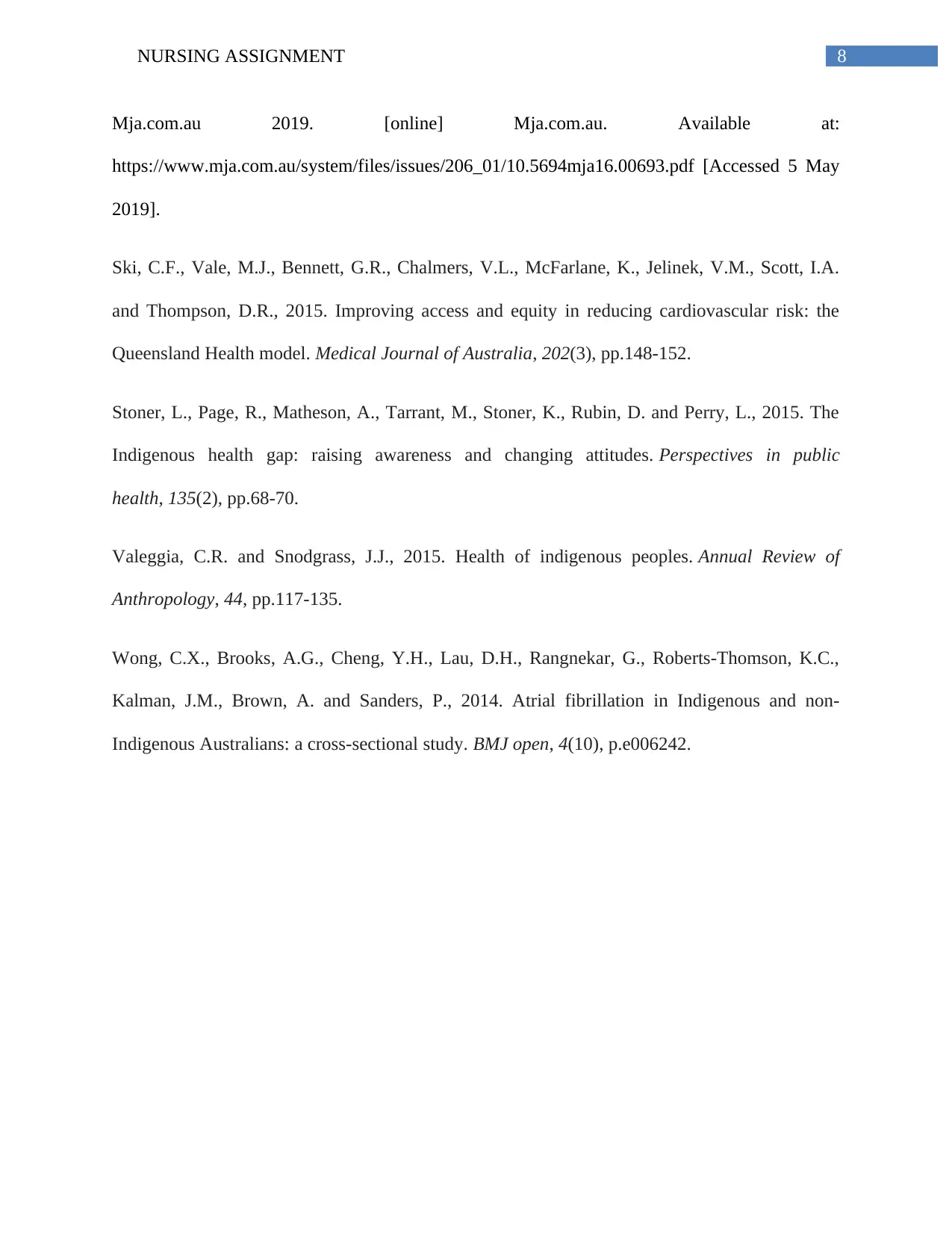
8NURSING ASSIGNMENT
Mja.com.au 2019. [online] Mja.com.au. Available at:
https://www.mja.com.au/system/files/issues/206_01/10.5694mja16.00693.pdf [Accessed 5 May
2019].
Ski, C.F., Vale, M.J., Bennett, G.R., Chalmers, V.L., McFarlane, K., Jelinek, V.M., Scott, I.A.
and Thompson, D.R., 2015. Improving access and equity in reducing cardiovascular risk: the
Queensland Health model. Medical Journal of Australia, 202(3), pp.148-152.
Stoner, L., Page, R., Matheson, A., Tarrant, M., Stoner, K., Rubin, D. and Perry, L., 2015. The
Indigenous health gap: raising awareness and changing attitudes. Perspectives in public
health, 135(2), pp.68-70.
Valeggia, C.R. and Snodgrass, J.J., 2015. Health of indigenous peoples. Annual Review of
Anthropology, 44, pp.117-135.
Wong, C.X., Brooks, A.G., Cheng, Y.H., Lau, D.H., Rangnekar, G., Roberts-Thomson, K.C.,
Kalman, J.M., Brown, A. and Sanders, P., 2014. Atrial fibrillation in Indigenous and non-
Indigenous Australians: a cross-sectional study. BMJ open, 4(10), p.e006242.
Mja.com.au 2019. [online] Mja.com.au. Available at:
https://www.mja.com.au/system/files/issues/206_01/10.5694mja16.00693.pdf [Accessed 5 May
2019].
Ski, C.F., Vale, M.J., Bennett, G.R., Chalmers, V.L., McFarlane, K., Jelinek, V.M., Scott, I.A.
and Thompson, D.R., 2015. Improving access and equity in reducing cardiovascular risk: the
Queensland Health model. Medical Journal of Australia, 202(3), pp.148-152.
Stoner, L., Page, R., Matheson, A., Tarrant, M., Stoner, K., Rubin, D. and Perry, L., 2015. The
Indigenous health gap: raising awareness and changing attitudes. Perspectives in public
health, 135(2), pp.68-70.
Valeggia, C.R. and Snodgrass, J.J., 2015. Health of indigenous peoples. Annual Review of
Anthropology, 44, pp.117-135.
Wong, C.X., Brooks, A.G., Cheng, Y.H., Lau, D.H., Rangnekar, G., Roberts-Thomson, K.C.,
Kalman, J.M., Brown, A. and Sanders, P., 2014. Atrial fibrillation in Indigenous and non-
Indigenous Australians: a cross-sectional study. BMJ open, 4(10), p.e006242.
1 out of 9
Related Documents
Your All-in-One AI-Powered Toolkit for Academic Success.
+13062052269
info@desklib.com
Available 24*7 on WhatsApp / Email
![[object Object]](/_next/static/media/star-bottom.7253800d.svg)
Unlock your academic potential
© 2024 | Zucol Services PVT LTD | All rights reserved.





